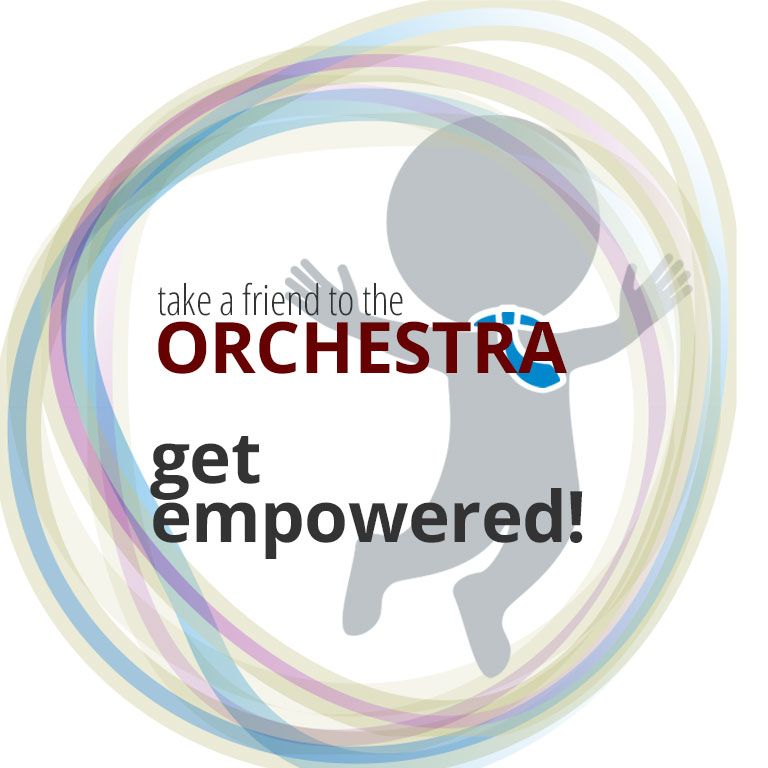As TAFTO 2007 comes to a close we bring the program around full circle: we started with a contribution from a manager and we’ll end with a contribution from a manager. Nashville Chamber Orchestra executive director Connie Linsler Valentine approaches the TAFTO idea be allowing you to walk a mile in her shoes. In particular, she takes you through the perspective of someone on the inside of a classical music ensemble and the paths taken when designing a concert experience…
Take A Friend To Orchestra
By: Connie Linsler Valentine
Most of us only go to new places when our friends lead us there. Every marketing guru will tell you that sales are all about one-on-one relationships. I am convinced that in each of our cities, our orchestras can become the “now” phenomenon by involving the right connectors, mavens and salesmen as described in Malcom Gladwell’s The Tipping Point. We all love the music, and we want to share that love with everyone, but the way to get people through the door is to create a warm and inviting community, get people involved, and then make them feel good about the experience.
To that end, I bring a two-tiered approach to TAFTO. First, we want to bring people to the music in a way that will give them a fair opportunity to come to love the art form as we do. And, second, our responsibility as members of the orchestra family, is to create a positive and welcoming environment with a sense of community.
We have to remember that the reason classical music can be viewed as foreign and intimidating is that many people have had little exposure to it as children, and what limited access they did have was usually in the form of one or two youth concerts. In my case, my father played the bass fiddle (sans bow) in a band on weekends and my mother played the accordion (very well, mind you). My whole family knew the “Too Fat Polka.” My uncle was a jazz clarinetist, and since I was not enamored by the bass fiddle or accordion, I inherited his old Selmer and with it ventured out to share my raw talent in the school band. My first exposure to orchestral music did not come until the fifth grade when the Buffalo Philharmonic performed Beethoven’s Fifth in our school gymnasium. I was emotionally transformed by that concert. I remember feeling a lump growing in my throat and starting to cry. My friend Crystal laughed at me, but I didn’t care. It was one of those life-changing moments. It was here that I discovered the cello, and if I had access to a string program, I would probably be a cellist today–maybe a bad one, but a cellist, nonetheless. As I grew older, I began collecting orchestral recordings, but I did not hear another live professional orchestra concert until I was in college. Can you imagine? Well, actually, that is the case for many of our “friends who don’t regularly participate in live music events.” I think of my friend Crystal, and I imagine she has never been to another orchestra concert. So, coming from a non-classical background, I have been thinking about, and trying to implement, ways to turn my friends on to the phenomenon of orchestral music all of my adult life.
In my 20’s I had a slightly different method for introducing friends to classical music than I do now. I was an orchestra manager in Midland-Odessa at the time, but also a volleyball fanatic. My life was orchestra and volleyball. None of my volleyball colleagues had ever been to an orchestra concert, but they all loved the likes of Michael Jackson, Dire Straits and Madonna, who were among the top pop artists of the day. I felt that if they liked those artists, they might appreciate great classical masterpieces. Don’t ask me why, I was young and I just believed it. After all, I liked both. So, to introduce them to the classical world, after a match (volleyball, that is) I would have them get in my car and I would put on Dvorak, Mahler, Tchaikovsky or Beethoven, crank the stereo and say “is this not the coolest thing you’ve ever heard?!” I played the music just loudly enough for them to engage, and so they could feel the visceral energy. Then, I would invite them to one of our concerts, at the venue with the better acoustics, which featured a work that I thought they would like. Every one of my six volleyball friends who came to a concert loved it! Of course I knew each of their tastes, and chose concerts I thought would be a match.
The whole idea of sound energy is so important to our orchestra world. I don’t necessarily mean the volume of the sound, but rather the energetic presence of even the softest of passages. To be able to hear an orchestra perform in a hall with great acoustics is such a gift to listeners and to our art form. This is why it is so exciting to see so many cities investing in new concert halls which will bring that richness of sound to life.
As I started to write this, I was reminded of an experience I had in Akron in the mid-1990’s. In support of building the symphony’s youth orchestra, I attended a high school orchestra performance. It was certainly a blunt reminder of why I was not a high school band or orchestra director! But, when I looked around and felt the energy of the room, I took note. There was something in the air. It was intense pride, camaraderie, community, support, and love. It came from parents, grandparents, brothers and sisters. In that hall was the extended family of the orchestra. Here were the people who invested in the instruments, the ones who struggled with their kids through the hours of practice, the ones who laughed and cried with them, and the ones who were even given a copy of Festive Overture by the orchestra director to listen to with their kids. Here were people who loved their children, and thus were open to loving what their children were experiencing.
It seems simplistic, but sitting there, I felt an epiphany. We are, or should be, about family and community.
So, how do we invite someone from outside the family to be engaged in this experience and what makes it a good experience? How do we make them feel comfortable being a part of the family?
We make them insiders from the beginning. We help them understand their new family-as much as anyone can understand their own family. We make them feel comfortable in their new home. We make them comfortable with listening to great music. We don’t change the music, but we create an experience which just feels good. With that, all else will fall in place. Not everyone will love all of the music, but if they can feel good about being part of the family, it gives them time to try more and learn about their own tastes.
How do we accomplish this? We introduce them to the musicians, staff, subscribers, donors and other friends and family. We show them the conductor’s dressing room. We give them samples of the music before they come. We find the best parking options for them. We make them feel comfortable enough to ask why the orchestra tunes. We share the music in advance of the concert. We show, tell and explain everything about the experience (before the concert starts, of course). We talk to them from the stage, and we bring them onstage. We laugh with them, and we take them seriously.
Please forgive the shameless self-promotion, but I would be remiss if I did not share a little about the work of the Nashville Chamber Orchestra (NCO) as we are embarking upon a new audience engagement program. Our theme is Music Without Boundaries and the orchestra’s mission is to present traditional classical works alongside new works which celebrate Nashville’s great eclectic music community. In the last ten years, the NCO has commissioned 36 (!) new pieces of music. The NCO’s first commission, Blackberry Winter is a dulcimer concerto by Conni Ellisor, our recording of which is frequently played on NPR, and the orchestra’s most recent commission was a work for orchestra and klezmer band by Michael Rose, premiered as part of the NCO Jewish-American Music Festival. All of our concerts feature new music, in conjunction with community partnerships.
The NCO is part of the Mellon Foundation’s recent New Strategies Lab to create new projects that may be come best practices for orchestras. Through the Lab, the orchestra, in partnership with Belmont University, has developed an online community engagement project designed to give the public a behind-the-scenes view of the creative process. The project, set to launch in June, will also have an “in person” aspect as well. I know that several orchestras are engaging in similar offerings, and it is certainly the wave of the future for all of us. These types of programs can be great tools for our family members to use when introducing new friends to the orchestra experience. It just might provide the tipping point.
There is new hope for orchestras, as the trend for teenagers and young adults is a return to the live concert experience. As these young people make their choices about participation in both music making and the live concert experiences they will attend, we have an opportunity to capture their open-minded imaginations, and the imaginations of those who love them, with the great music we care about so deeply.

